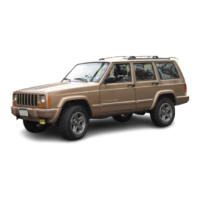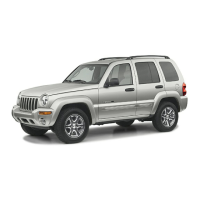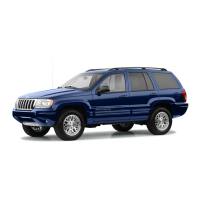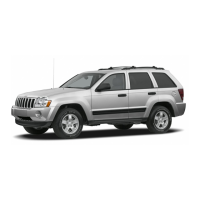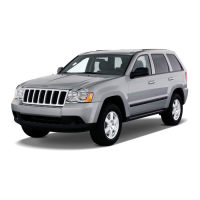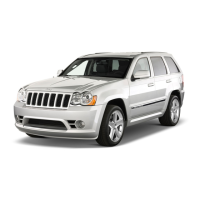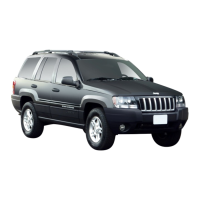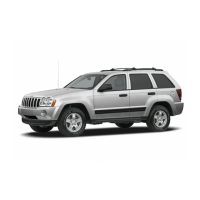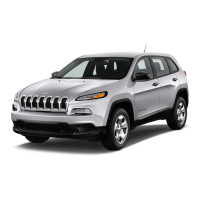Do you have a question about the Jeep Cherokee 2009 and is the answer not in the manual?
Location and purpose of the Vehicle Identification Number.
Warnings about modifying the vehicle and potential safety impacts.
Information about the vehicle's keys and their functions.
Details on the Sentry Key Immobilizer System and its operation.
Explanation of the security alarm system, arming, and disarming.
Features of the premium security system, including intrusion sensors.
How the interior lights activate upon door unlock or opening.
System for locking/unlocking doors and liftgate remotely.
Instructions for operating manual door locks.
Using the power door lock switches to lock/unlock doors.
How the doors automatically lock when the vehicle reaches a certain speed.
Feature that automatically unlocks doors when exiting the vehicle.
How to engage and disengage the rear door child safety locks.
Operation of power windows via the driver and passenger controls.
Automatic lowering of driver's window with a single touch.
Automatic closing of windows with anti-pinch safety feature.
Disabling or enabling window controls for passengers.
Information on the proper use and operation of lap/shoulder belts.
How pretensioners remove slack from seat belts during a collision.
System warning the driver to buckle up.
Automatic pre-locking of shoulder belts for child safety seats.
Feature designed to reduce belt force on the occupant's chest.
Recommendations for pregnant women using seat belts.
Explanation of front and side airbags as a supplement to seat belts.
Safety recommendations for restraining infants and small children.
Guidelines for restraining older children in forward-facing seats.
Warning against transporting passengers in unauthorized areas.
Importance of locking the vehicle when unattended.
Periodic inspection of seat belt systems for cuts, frays, and proper function.
Checking tires for wear, damage, and proper inflation.
Verifying the operation of all exterior lights.
Checking door latches for positive closing and locking.
Inspecting under the vehicle for any fluid leaks.
Information on inside day/night, automatic dimming, and outside mirrors.
Details on the UConnect system for voice-activated communication.
How to access a brief tutorial for system features.
Feature to improve voice recognition accuracy.
Tips for optimal performance of the voice recognition system.
Moving calls between the phone and the UConnect system.
Managing the Bluetooth connection between phone and system.
How to view a list of paired cellular phones.
Adjusting front seats manually for position and comfort.
Steps to store preferred seat, mirror, and radio settings.
Pairing RKE transmitters to recall memory positions.
How to recall stored seat and mirror positions.
Using the multifunction lever to control various lights.
Operation of parking lights and headlights.
System that automatically turns headlights on/off based on ambient light.
Headlights activating automatically with wipers.
Feature to keep headlights on for a period after exiting the vehicle.
Chime alert when lights are left on with the driver's door open.
How to activate the front fog lights.
Operation of turn signals for lane changes and regular turns.
Using the intermittent wiper system for variable pause between cycles.
How to activate, set, resume, and deactivate cruise control.
Important safety and operational precautions for the Sky Slider roof.
Location of the front storage compartment.
Description of the center console's storage compartment.
Features of the cargo load floor system, including storage bin.
Operation of the rear window wiper and washer system.
Steps for safely starting the vehicle's engine.
How to manually override the shift lock mechanism.
Operating information for the Selec-Trac II transfer case.
Situations where using 4WD LOW range is appropriate.
How ABS helps maintain vehicle control during braking.
System that monitors and reduces wheel spin.
System that optimizes braking capability during emergency maneuvers.
How HSA assists during acceleration on an incline while towing.
How to disable the Hill Descent Control system.
Importance of proper tire inflation for safety and performance.
How the base TPMS uses sensors to monitor tire pressure.
Location and proper use of the fuel filler cap.
Information found on the vehicle certification label.
Maximum permissible weight of the vehicle including load.
Definition of payload as allowable load weight.
Definitions of terms related to trailer towing.
Advice for automatic transmission use when towing.
How to activate and use the hazard warning flashers.
Actions to take if the engine overheats.
Procedures for safely jacking the vehicle and changing a tire.
Diagram and identification of engine compartment components.
Procedures for checking and changing engine oil.
How to check coolant levels and condition.
Procedures for draining, flushing, and refilling the cooling system.
How to check the automatic transmission fluid level.
How to check the transfer case fluid level.
Recommendations for protecting the vehicle's body and paint from corrosion.
Cleaning the low-glare instrument panel cover.
How to clean interior trim materials.
Recommended methods for cleaning leather upholstery.
Optional fabric protectant application for the top.
Caution regarding cleaning the top fabric.
Steps for removing stubborn stains from the top fabric.
Bulb types and numbers for interior lights.
Bulb types and numbers for exterior lights.
Step-by-step instructions for replacing headlight bulbs.
How to replace front turn signal bulbs.
Instructions for replacing front fog light bulbs.
Specifications for engine coolant, oil, spark plugs, and fuel selection.
Recommended maintenance intervals for gasoline engines.
Steps to take when seeking assistance from the manufacturer or dealer.
Location and purpose of the Vehicle Identification Number.
Warnings about modifying the vehicle and potential safety impacts.
Information about the vehicle's keys and their functions.
Details on the Sentry Key Immobilizer System and its operation.
Explanation of the security alarm system, arming, and disarming.
Features of the premium security system, including intrusion sensors.
How the interior lights activate upon door unlock or opening.
System for locking/unlocking doors and liftgate remotely.
Instructions for operating manual door locks.
Using the power door lock switches to lock/unlock doors.
How the doors automatically lock when the vehicle reaches a certain speed.
Feature that automatically unlocks doors when exiting the vehicle.
How to engage and disengage the rear door child safety locks.
Operation of power windows via the driver and passenger controls.
Automatic lowering of driver's window with a single touch.
Automatic closing of windows with anti-pinch safety feature.
Disabling or enabling window controls for passengers.
Information on the proper use and operation of lap/shoulder belts.
How pretensioners remove slack from seat belts during a collision.
System warning the driver to buckle up.
Automatic pre-locking of shoulder belts for child safety seats.
Feature designed to reduce belt force on the occupant's chest.
Recommendations for pregnant women using seat belts.
Explanation of front and side airbags as a supplement to seat belts.
Safety recommendations for restraining infants and small children.
Guidelines for restraining older children in forward-facing seats.
Warning against transporting passengers in unauthorized areas.
Importance of locking the vehicle when unattended.
Periodic inspection of seat belt systems for cuts, frays, and proper function.
Checking tires for wear, damage, and proper inflation.
Verifying the operation of all exterior lights.
Checking door latches for positive closing and locking.
Inspecting under the vehicle for any fluid leaks.
Information on inside day/night, automatic dimming, and outside mirrors.
Details on the UConnect system for voice-activated communication.
How to access a brief tutorial for system features.
Feature to improve voice recognition accuracy.
Tips for optimal performance of the voice recognition system.
Moving calls between the phone and the UConnect system.
Managing the Bluetooth connection between phone and system.
How to view a list of paired cellular phones.
Adjusting front seats manually for position and comfort.
Steps to store preferred seat, mirror, and radio settings.
Pairing RKE transmitters to recall memory positions.
How to recall stored seat and mirror positions.
Using the multifunction lever to control various lights.
Operation of parking lights and headlights.
System that automatically turns headlights on/off based on ambient light.
Headlights activating automatically with wipers.
Feature to keep headlights on for a period after exiting the vehicle.
Chime alert when lights are left on with the driver's door open.
How to activate the front fog lights.
Operation of turn signals for lane changes and regular turns.
Using the intermittent wiper system for variable pause between cycles.
How to activate, set, resume, and deactivate cruise control.
Important safety and operational precautions for the Sky Slider roof.
Location of the front storage compartment.
Description of the center console's storage compartment.
Features of the cargo load floor system, including storage bin.
Operation of the rear window wiper and washer system.
Steps for safely starting the vehicle's engine.
How to manually override the shift lock mechanism.
Operating information for the Selec-Trac II transfer case.
Situations where using 4WD LOW range is appropriate.
How ABS helps maintain vehicle control during braking.
System that monitors and reduces wheel spin.
System that optimizes braking capability during emergency maneuvers.
How HSA assists during acceleration on an incline while towing.
How to disable the Hill Descent Control system.
Importance of proper tire inflation for safety and performance.
How the base TPMS uses sensors to monitor tire pressure.
Location and proper use of the fuel filler cap.
Information found on the vehicle certification label.
Maximum permissible weight of the vehicle including load.
Definition of payload as allowable load weight.
Definitions of terms related to trailer towing.
Advice for automatic transmission use when towing.
How to activate and use the hazard warning flashers.
Actions to take if the engine overheats.
Procedures for safely jacking the vehicle and changing a tire.
Diagram and identification of engine compartment components.
Procedures for checking and changing engine oil.
How to check coolant levels and condition.
Procedures for draining, flushing, and refilling the cooling system.
How to check the automatic transmission fluid level.
How to check the transfer case fluid level.
Recommendations for protecting the vehicle's body and paint from corrosion.
Cleaning the low-glare instrument panel cover.
How to clean interior trim materials.
Recommended methods for cleaning leather upholstery.
Optional fabric protectant application for the top.
Caution regarding cleaning the top fabric.
Steps for removing stubborn stains from the top fabric.
Bulb types and numbers for interior lights.
Bulb types and numbers for exterior lights.
Step-by-step instructions for replacing headlight bulbs.
How to replace front turn signal bulbs.
Instructions for replacing front fog light bulbs.
Specifications for engine coolant, oil, spark plugs, and fuel selection.
Recommended maintenance intervals for gasoline engines.
Steps to take when seeking assistance from the manufacturer or dealer.
| Brand | Jeep |
|---|---|
| Model | Cherokee 2009 |
| Category | Automobile |
| Language | English |
